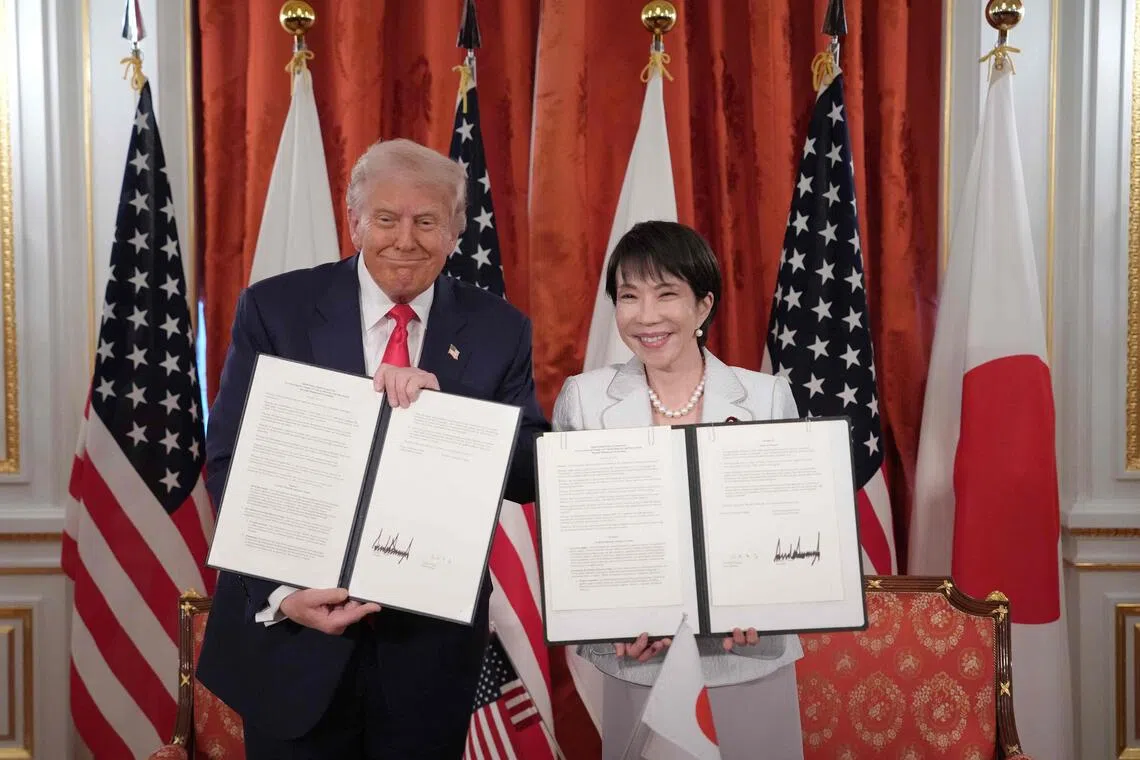Trump, Japan PM Sanae Takaichi ink rare earths deal ahead of Trump-Xi meeting
Sign up now: Get ST's newsletters delivered to your inbox

US President Donald Trump and Japanese Prime Minister Sanae Takaichi signed a framework agreement for securing the supply of rare earths on Oct 28.
PHOTO: AFP
Follow topic:
TOKYO – Japanese Prime Minister Sanae Takaichi and US President Donald Trump on Oct 28 signed a framework agreement for securing the supply of rare earths as both countries aimed to reduce China’s dominance of some of the key electronic components.
The leaders signed the documents, which included the issue of critical minerals, at the neo-Baroque-style Akasaka Palace in Tokyo as aides applauded.
No direct mention was made publicly by the leaders about China, which processes more than 90 per cent of the world’s rare earths, making it the source of each country’s concern about its mineral supply chain.
Beijing has recently expanded export curbs
Japan and the US will use economic policy tools and coordinated investment to speed up the “development of diversified, liquid and fair markets for critical minerals and rare earths”, and aim to provide financial support to selected projects within the next six months, the White House said.
Both countries will consider a mutually complementary stockpiling arrangement and cooperate with other international partners to ensure supply chain security, it added in a statement.
While the sector is dominated by China, the US and Myanmar control 12 per cent and 8 per cent respectively of global rare earth extraction, according to the Eurasia Group, and Malaysia covers another 4 per cent of processing and Vietnam 1 per cent.
US energy supplies
Japan has pledged a US$550 billion (S$712 billion) investment
Ahead of Mr Trump’s Asia trip, the US called on Russian energy buyers, including Japan, to cease imports, and imposed sanctions on Moscow’s two biggest oil exporters – Rosneft and Lukoil – to push the Kremlin to the negotiation table to end the war in Ukraine.
Japan has stepped up US LNG purchases in the last few years as it tries to diversify away from its key supplier Australia and prepare for supply contract expirations from Russia’s Sakhalin-2 LNG project, which Mitsui and Mitsubishi helped to launch in 2009.
In June, Jera, Japan’s top LNG buyer, agreed to buy up to 5.5 million tonnes per annum of US LNG under 20-year contracts, with deliveries starting around 2030. This is roughly the same amount that Japan imports annually from Sakhalin-2.
Most supply from Sakhalin-2, which covers 9 per cent of Japan’s gas needs, ends in 2028-2033. Japan buys less than 1 per cent of its oil imports from Russia under a sanctions waiver, with the bulk of its oil supply covered by the Middle East.
Last week alone, Japan’s biggest city gas supplier, Tokyo Gas, signed a preliminary deal to buy one million tonnes per annum of LNG from the Alaska LNG project, following a similar announcement from Jera in September.
Jera pledged US$1.5 billion for gas assets in Louisiana in its first foray into upstream production in the US, where Tokyo Gas and Mitsui are already present.
To keep electricity prices in check, Japan wants to continue Sakhalin-2 LNG imports, a senior official has said, as it takes only a few days to deliver LNG to Japan compared with around a week from Alaska and roughly a month from the US Gulf Coast.
“The US said it wants Japan to stop importing Russian energy – but this is Japan’s closest LNG source and which is also cheap,” said chief executive Nobuo Tanaka of the Tanaka Global advisory.
“I think the question should be framed this way: Can the US provide Japan with LNG as cheap as what currently comes from Russia? Can gas from Alaska be that affordable?” REUTERS

